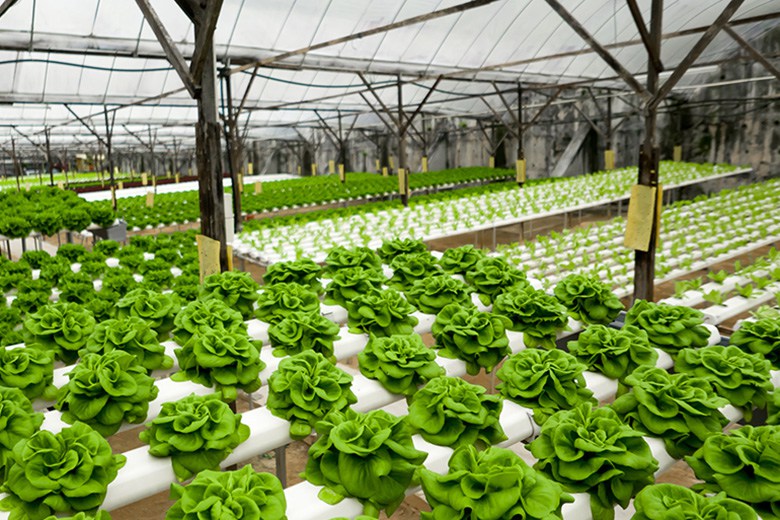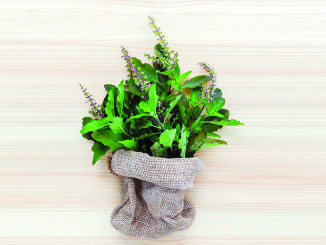
Hydroponically grown lettuce, tomatoes, strawberries and herbs make up an ever-increasing share of produce on display at many grocery stores and farmers markets. But growing plants indoors in controlled conditions is hardly new. For centuries, large- and small-scale growers have used greenhouses and container gardening to extend the growing season, create ideal growing conditions and increase growing space. What makes hydroponics different is the absence of soil.
Instead of drawing water and nutrients from soil, hydroponic produce is grown with the roots submerged in nutrient-fortified water. Aeroponics is a related method in which the roots hang in the air and are regularly misted with water and nutrients.
One benefit of hydroponic farming is that it allows large amounts of produce to be grown on a relatively small piece of land and in places where traditional farming would be untenable, such as urban centers, or limited by geography and weather, such as in Alaska.
Hydroponic growers help satisfy demand for local produce in areas that are not well-suited for traditional farming. But even in farm-friendly regions where rain and sun are plentiful, storms, heat waves and unexpected freezes can cause unpredictable and costly crop losses, to which indoor farmers are largely immune.
Hydroponic crops also are less susceptible to weeds, insects and other pests, which means the plants can be produced without herbicides and pesticides.
All this has made hydroponics one of the fastest growing sectors of the agriculture industry, with more traditional growers investing in hydroponics as a supplement to existing operations or switching over entirely.
Another potential advantage of hydroponic farming is the degree of control the grower has over the conditions to which plants are exposed and the ability to precisely replicate those which produce better results.
However, not every plant does equally well in hydroponic growing conditions, at least with current technology. Lettuce and other leafy greens, herbs, tomatoes, peppers, cucumbers and strawberries are the most commonly grown hydroponics.
Hydroponic operations, which often use sophisticated water recycling systems, may use up to 90 percent less water than traditional farming, depending on the location. While traditional farms in water-stressed areas rely heavily on irrigation and use far more water than hydroponics, other areas get most of their water from rain.
Some hydroponic growers also rely on electric grow-lights instead of the sun. This allows growers to artificially extend the length of the day and manipulate light wavelengths to increase yield and productivity year-round.
Not having to till and plow fields can reduce the amount of greenhouse gasses associated with crop production. However, the overall carbon footprint of a food depends on additional factors, such as the distance it is transported after harvest, which complicates comparisons of environmental impact between hydroponically and soil-grown crops.
How Do Hydroponics Compare Nutritionally?
Comparing the nutritional content of hydroponic and soil-grown produce is challenging, and research involving direct comparisons is limited. Both traditional and hydroponic farmers can influence the nutritional content of produce by adding nutrients to the soil or growing medium. But the nutritional composition of a fruit or vegetable also depends on the particular cultivar or variety, the degree of ripeness when harvested and the storage period after harvest.
With hydroponics, there is no danger of plants absorbing heavy metals that may be in the soil. On the other hand, growing vegetables in soil may yield benefits that we don’t yet fully understand. Raw produce can be a source of beneficial probiotic soil-based bacteria, for example. Although it’s not yet clear to what extent this can be replicated indoors, commercial hydroponic growers are experimenting with techniques that foster a healthy and diverse microbiome.
What about Flavor?
Although you may think sun and soil are essential for good flavor, the factors that influence flavor — including air temperature, humidity, the amount and color spectrum of light-nutrient availability and moisture — can be precisely controlled and more reliably replicated in a hydroponic environment.
As with nutrient content, the flavor of produce depends on the variety and freshness, as well as growing conditions. “We can breed for flavor, texture and nutrition instead of mold resistance, pest resistance or shelf life,” says Alina Zolotareva, RDN, marketing manager for AeroFarms, an aeroponic grower of salad greens in Newark, N.J. “And because hydroponics can move the farms to the people, it can give people access to fresher produce.”
But the hydroponic produce at a local grocer isn’t necessarily grown locally. Although hydroponics make it possible to grow fruits and vegetables anywhere, the largest hydroponic growers in the U.S., accounting for about half of hydroponic sales, are clustered in Pennsylvania, California, New York, Vermont and Wisconsin.
The Organic Debate
Because hydroponically grown fruits and vegetables can be produced without the use of pesticides or herbicides, many hydroponic growers are pursuing organic certification, which allows produce to be sold at a higher price point. But many traditional organic farmers are crying foul.
“[Hydroponics] is a really efficient model of production,” says Mark Kastel, co-founder of The Cornucopia Institute, a public interest group supporting sustainable and organic agriculture. “If unchecked, hydroponics could squeeze out traditional organic farmers to the extent that consumers wouldn’t really have the option to buy soil-grown organic produce.”
“Allowing hydroponic produce to be certified as organic is completely contrary to the values of the organic movement,” Kastel says. “Improving and maintaining the health and biodiversity of soil is one of the core principles of organic growing. How can you be stewarding the soil if there is no soil?”
Proponents of organic hydroponics argue that hydroponic systems are aligned with the principles of stewardship, conservation and environmental harmony outlined in the Organic Foods Production Act of 1990. They also view new technology, such as hydroponics, as essential to meeting the demand for organics.
In 2010, the National Organic Standards Board, or NOSB, a federal advisory board, petitioned the United States Department of Agriculture to make hydroponically grown vegetables ineligible for organic certification, a recommendation that the USDA has so far declined to adopt.
“The USDA has made it clear that hydroponics will be allowed to be certified organic,” says Nate Lewis, farm policy director for the Organic Trade Association. “At the very least, we’d like to see a rule that requires hydroponically grown vegetables to be labeled as such.”
In April 2017, the NOSB convened and discussed potential recommendations it would provide the USDA for organic certification of hydroponic systems. No decisions were made, and the Crops Subcommittee will be developing a proposal on this topic for a meeting in the fall.







